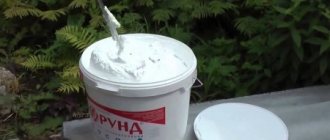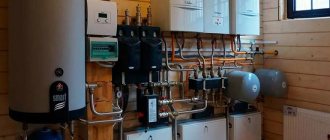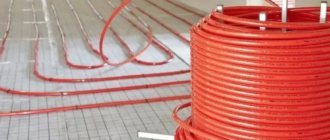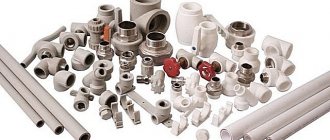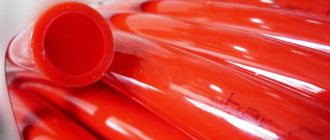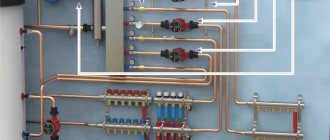Foamed polyethylene insulation also has another name - polyethylene foam (PPE). It is used to reduce the intensity of heat loss; in fact, this material is in many ways superior to some analogues, which is due to its closed-porous structure . PPE is characterized by a large number of positive qualities - minimal thickness, low thermal conductivity, etc. Insulation of this type is installed without unnecessary difficulties. In addition, the film is elastic, which allows better protection of complex surfaces.
Main characteristics and features of the material
The insulation is made from foamed polyethylene, which ensures its ability to protect surfaces from moisture. It represents a class of gas-filled thermoplastic polymers. The content of gaseous substances inside the pores helps to improve the thermal insulation properties. Another name for materials in this group is polymer foams and thermoplastics. To obtain PPE with the desired properties, high/low pressure polyethylene is used as a raw material. Different production technologies are used:
- direct extrusion;
- foaming of polyethylene material through a gaseous medium.
First, the raw material is melted at a temperature of +115 °C. When the desired consistency is achieved, add gas/nitrogen. Such substances contribute to the structuring of polyethylene.
The foaming process is implemented using the following methods:
- physical;
- chemical.
To avoid the formation of larger inclusions, the mass, consisting of gas-filled capsules, rotates continuously. After some time, the liquid material is poured into molds and cooled. Taking into account differences in production methods, different types of insulation are created:
- gas foam (not cross-linked);
- cross-linked foamed by physical/chemical means.
During the manufacture of the latter option, changes occur at the molecular level: a three-dimensional mesh is formed, which is possible after linking molecules and forming cross connections. If we consider insulation obtained by physical and chemical cross-linking, in this case there is no significant difference in the structure, but there is a difference in the production methods. The coating is made on the basis of foamed polyethylene in two versions: rolls, mats.
Varieties
Foamed polyethylene is a material that is sold in rolls. At the same time, in the process of purchasing it, you should be as careful as possible, since there are several varieties of PE that differ in their quality properties and are also used to perform various tasks.
Unstitched
Rolled foamed non-crosslinked polyethylene is produced using the so-called “physical foaming” technology. This manufacturing method allows you to preserve the original structure of the material. As for the strength characteristics of this type of PE, they are relatively low, which must be taken into account when purchasing and using the material. In general, it is believed that non-crosslinked material is suitable for use in cases where it will not be subject to significant mechanical stress.
Stitched
As for cross-linked foamed PE, there are two types of such material: chemically and physically cross-linked. Let's look at the characteristics of these types in more detail.
The production of chemically cross-linked material occurs step by step. First of all, the procedure of mixing the raw materials with special foaming and cross-linking elements is carried out. After this, the initial workpiece is formed. The next step is to gradually heat the prepared mass in the oven. It should be noted that the process of temperature treatment of the composition affects the appearance of special cross-links between the polymer threads (this process is called “cross-linking”, which is where the name of the material comes from). After this, gas formation occurs. As for the direct properties of the material that is obtained through the use of this method, characteristics such as fine-porous structure, matte surface, high strength and stability, elasticity, etc. should be noted.
Unlike the material described above, special additives are not used to create the final product, which is produced by physical cross-linking . In addition, there is no heat treatment step in the production cycle. Instead, the prepared mixture is treated with a flow of electrons, which promotes the crosslinking process.
It is also important to note the fact that by using this method, the manufacturer has the ability to control the characteristics of the material and the size of its cells.
Scope of application
Foam insulation is used in various industries, which is made possible due to its excellent thermal and sound insulation, as well as a number of other properties. Main areas of application:
- construction of facilities for various purposes;
- packaging material;
- furniture manufacturing;
- production of sports equipment;
- production line for prosthetic and orthopedic products;
- light industry;
- electrical engineering;
- Automotive industry;
- shipbuilding.
The use of foamed polyethylene is justified in any cases where it is necessary to provide protection from noise, reduce the intensity of heat loss, and also provide waterproofing.
The possibility of using insulation on different objects is due to its versatility. You should know that it is allowed to use cross-linked PPE, which was made by chemical or physical compounding, for the same purposes. This type of coating is used to insulate various objects, surfaces and objects, including:
- double glazed windows;
- doors;
- underlay for laminate;
- foundation;
- floor;
- walls;
- roof;
- ventilation systems;
- car interior, etc.
Types by production method
To simplify the explanation, polyethylene foam is divided into “cross-linked” and “non-cross-linked” according to the production method, although the technologies used for each type may differ. The main difference between the resulting materials is that during production the molecular structure of “uncrosslinked” polyethylene foam does not change, unlike “crosslinked” one, although both materials are called foamed.
Each of the resulting types of material has a number of distinctive features and, as a result, slightly different areas of application. The technology of “cross-linking” refers to the process of forming cross-links of molecular links into a three-dimensional region with wide cells.
Comparison of manufacturers and prices
Insulation based on polyethylene foam is available in different price categories. Review of manufacturers and average prices:
- Penofol: 1400 rubles/roll – foil covering ( 3 mm, length 30 thousand mm), 2000 rubles/roll – insulation 10 mm thick, 15 thousand mm long.
- Tepofol: with a thickness of 2 mm, the cost is 400 rubles; thickness 5 mm – 1000 rub.
- Energoflex pipe insulation: 15 RUR/roll ( 22x9 mm); 145 RUR/roll ( 110/13 mm).
- Isoflex: 700 RUR/roll ( 25 m length, 2 mm thickness).
If you plan to insulate with polyethylene foam, you should know that the cost is influenced by a number of factors: thickness, length and width of the roll covering. In addition, PPE with a foil layer will cost more than insulation without heat-reflecting material.
Choose your own thermal insulation for polyethylene foam pipes!
Polymer foam is a favorable and pliable material for the production of products of various configurations. This explains the wide range of pipe insulation sold on the Baustov company website. Let's look at the features of the materials, read our short review!
Honored leader of domestic thermal insulation made of foamed polyethylene - Energoflex
famous for its tubes and rolls for insulation of air conditioning and heating systems with a diameter of 22 to 108 mm.
- Energoflex Acoustic - noise-absorbing thermal insulation made of polyethylene foam for sewerage. It has a special structure in the form of tubes with longitudinal corrugation inside.
- Energoflex Super Protect – tubes with a red or blue outer sheath. Designed for insulation of cold and hot water supplies with medium temperatures up to +95 °C.
- Energoflex® Black Star Split pipe insulation with a durable polymer coating that protects polyethylene foam from ultraviolet radiation and atmospheric conditions. Designed for insulation of copper communications, used for air conditioning systems.
- Energoflex Super is an insulation resistant to aggressive environments in the form of flexible tubes that effectively reduce heat loss and structural noise.
- Energoflex Super SK pipes are pipe insulation with a longitudinal cut, with an adhesive layer applied at the joints. In turn, before installation, the adhesive composition is protected with a special anti-adhesive film.
- Energofloor Compact rolls are made from synthetic foam covered with aluminum foil. It is used in the installation of heated floors.
Penofol
This is a multi-layer coating based on polyethylene foam. It is covered with a foil layer on one or both sides. This type of insulation may differ in density, structure and thickness. Foiled polyethylene foam has the advantage of additionally reflecting heat emanating from the room, thereby reducing heat loss. Characteristics of foam material:
- temperature regime: – 60 …+ 100 °C;
- high heat reflection coefficient (97%);
- low thermal conductivity – 0.035 W/(m*K).
Safety of polyethylene foam
Polyethylene is one of the most stable compounds on the planet. Polyethylene granules, which are used to make thermal insulation, are used to make water cans and bottles, food packaging, and water pipes.
At the household level, if used within the operating temperature range, polyethylene foam is harmless. PPE is dangerous when heated above 110-120 0C.
When burned, it releases acetic acid, formaldehyde, and carbon monoxide.
The decay period of the material is about 200 years. This, on the one hand, makes it one of the most durable materials (which is good). But on the other hand, polyethylene, like plastic, is a real disaster for the earth’s ecology, since a large amount of foamed polyethylene waste accumulates.
Foam film
Produced by foaming polystyrene. The coating is characterized by a low thermal conductivity, which makes it possible to use it for insulation of various objects. This type of foam material contains fire retardants. These are special additives that reduce the degree of exposure of the coating to high temperatures. Despite this, the foam film still burns. The insulation has a significant drawback - toxic compounds are released during the combustion process.
The coating retains heat and moisture well. However, it does not allow air to pass through.
The recommended insulation thickness for Russian regions varies between
20-25 cm. Additionally, a waterproofing diffuse material should be used, as well as a vapor barrier. Thanks to this, the foamed foam will be well protected from the effects of moisture contained in the indoor air.
Types of fillings in jackets
What is polyester in a jacket? When buying a coat or other outerwear, people primarily focus on the weather and climate of their region. But this may not be enough, because polyester in jackets has different properties. You can ask a store consultant for more information about padding. Information about this is indicated on the tag. There are fillers that are easy to distinguish by tactile sensations (for example, padding polyester).
Thinsulate
Down of artificial origin, which in its properties differs little from natural fluff. Thinsulate was used to insulate astronaut suits. Today they are used to stuff winter clothes for sailors and sleeping bags for mountaineers. To what temperature is polyester suitable? Things insulated with Thinsulate can be worn at 30-60 degrees below zero. It all depends on how dense the layer is. The stuffing is suitable for sewing children's clothes. Thinsulate fiber produces lightweight and at the same time warm clothing that is highly breathable.
Its density is 100-480 g/m². Due to its softness and light weight, Thinsulate is in many ways similar to swan's down. It is in many ways identical to natural, but does not cause allergies. Thinsulate consists of microfibers that are surrounded by air membranes. This polyester insulation is thin enough, so you can sew elegant winter coats from it. Things made from this filler have one drawback - the high price.
Holofiber
Holofiber does not absorb moisture, as it quickly evaporates from it. At the same time, warmth can be retained in clothing. There are halofiber balls inside the outer sides of the material. This polyester jacket will keep you from freezing and sweating. The raw materials are used to sew children's clothes. It is safe for allergy sufferers and suitable for everyone. The properties of holofiber largely imitate down. It can withstand machine washing on a delicate cycle.
The density of the material ranges from 70 to 300 g/m². How many degrees is holofiber suitable for? It is recommended to wear it at temperatures from 5 degrees Celsius to 30 degrees below zero. It is wear-resistant and does not lose its thermal insulation properties for a long time. Winter jackets made from holofiber can be worn in low temperatures and strong gusts of wind.
Sintepon
At one time, the structure of this material was changed, and since then it has been used in the production of jackets and coats. Sintepon 150 g/m² is the minimum density of the material, the highest is 400 g/m². It perfectly retains its shape and retains heat; items made from it are sold at reasonable prices. Many people are interested in what temperature is a padding polyester 200 g m2 designed for? It is recommended to wear things with such padding at the end of autumn or at the very beginning of winter, if the temperature has not dropped to 10 degrees below zero. Things that can be worn at 25 degrees below zero are insulated with padding polyester with a density of 350 g per m².
Sintepooh
This polyester insulation is reminiscent of bird down in its properties. The polyester fiber in it is glued in it in a special way. Synthetic fluff is wear-resistant, does not wrinkle, and dries quickly. For the winter months, when the temperature drops to 25 degrees, you can wear jackets with synthetic down, the density of which is 250 g/m². In five-degree frost, a filler with a density of 60 g/m² is sufficient. According to its structure, such polyester insulation can be homogeneous or elastic.
Isosoft
This material comes in different types. One of them is isosoft, the fibers of which are made in the form of balls. It is easy to care for: after washing it dries quickly and is not subject to deformation in the machine. Isosoft is thin enough, so down jackets made from it do not look bulky. Density ranges from 80 to 300 g/m². At the same time, the layer retains heat well. It is several times better than synthetic winterizer in its thermal insulation properties.
Isosoft is very soft and elastic, wear-resistant and at the same time breathable. A relatively thin layer of isosoft will prevent you from freezing in frosty weather. You can wear a coat with this insulation both in winter and in the off-season.
Manufacturers advise you to find out the density of isosoft and at what temperature it can be worn:
- from 200 to 300 g/m² – severe winter up to 35 degrees below zero;
- from 100 to 150 g/m² – up to 10 degrees below zero;
- from 40 to 80 g/m² – not lower than 0 degrees.
To improve the thermal insulation characteristics of isosoft, you need to put something thick under your coat (for example, a fleece sweater). This is how you can insulate a demi-season down jacket made of isosoft if the weather unexpectedly changed on a trip and you didn’t have any warmer things with you.
Certain types of polyester linings are suitable for different temperatures and weather. When purchasing items with synthetic padding, it is worth asking a consultant about how and what the interlayer is made of, what its density is, as well as other properties.
Experts advise asking what brand of outerwear is and reading reviews. The main thing is to know at what temperature you can wear it, what the density is, whether it can withstand machine washing and what the quality of the layer is.
Advantages and disadvantages
Insulation, characterized by a closed-cell structure, has many positive qualities:
- Versatility. The material is suitable for insulating various types of surfaces and objects.
- Excellent moisture and heat protection indicators.
- Foam coating is used as sound insulation if a material with a thickness of 5 mm or more is used.
- Light weight.
- Environmentally friendly.
- Vapor tightness.
- During combustion, the insulation does not emit toxic substances.
- Fungus and mold do not appear on the surface of PPE.
- The foam material is resistant to chemical compounds, which is important in construction.
- Elasticity.
- Elasticity.
- Reasonable price.
- Long service period.
The coating has much fewer disadvantages. These include low strength characteristics. The foam material is not resistant to compressive loads. For this reason, PPE is more often used to insulate horizontal surfaces. Under the influence of ultraviolet radiation, the insulation loses its properties, so it is either covered with a protective coating, or an option is used with a foil layer on top of the base material.
Advantages and disadvantages
The main advantage of any insulation with a foil layer is its technical performance, which is significantly increased compared to similar materials, but without a foil layer. However, due to additional production costs and complicated technology, such a heat insulator is more expensive. In general, foil insulation has a lot of positive qualities.
Insulation with foil is significantly superior to conventional heat insulators
Advantages of the material:
- sound insulation;
- safety from an ecological point of view in most species;
- resistance to temperature changes;
- moisture resistance;
- easy installation;
- high thermal insulation properties;
- durability.
Pros and cons of foil insulation
The disadvantages of the material include softness, which prevents the use of foil insulation when laying some soft types of floor coverings, as well as high cost compared to ordinary thermal insulation materials.
Scope of application of polyester materials
High environmental friendliness allows the products to be used not only in the industrial sector, but also in everyday life. The hypoallergenic material is odorless and does not emit harmful substances; it is recommended for installation in children's rooms. Polyester is used in the production of a number of products:
- thermal insulation materials for buildings and pipelines;
- sound insulation of air ducts and ventilation systems;
- production of bedding (pillows, mattresses, blankets);
- fabrics and artificial fur;
- insulation for clothing;
- toy filler.
Features of 100% polyester
Skeptical perception of this material as insulation has grounds, but they can most likely be attributed to the consequences of past experience. So, in the past, many companies, especially enterprises from the USSR, produced insulation, which had a fairly high density, caked, wrinkled, and did not withstand washing and long-term use. Naturally, such material could not fulfill its purpose properly.
Currently, this type of fabric is produced not from straight threads, but from fibers rolled into tubes, spirals and other stable spatial structures. When worn and washed, modern polyester does not lose its shape and properties. This is enough for the material to have a low density and have excellent thermal insulation characteristics.
In what weather can 100% polyester insulation be used? Not too favorable in terms of temperature.
During its use, it acquired various trade names, which you should know in order to understand how to use clothes with such insulation. Below is a list of the most popular brands:
- Thinsulate;
- fiberskin;
- holofiber;
- polyfiber;
- isosoft;
- firetech.
Production of polyester fibers
Experiments with polyester (PE) yarns began in the 80s, but scientists are still creating various combinations of chemical raw materials to improve the properties of the final product. High-quality fiber is the basis of good insulation, so factories control every stage of production.
The main parameters of threads that affect the characteristics of the product are thickness, type of twist, uniformity and density. Any change in them leads to obtaining a material with new properties. The flexible structure of the fibers gives the insulation elasticity, resistance to tearing and compression.
Advantages of polyester insulation
The special thread has the shape of a small spiral and consists of a large number of intertwined fibers. It is the springy structure of the fiber that gives the polyester material the most valuable technical characteristics for use in everyday life and industry.
The particularly valuable properties of the material include high strength, resistance to deformation, low weight, low susceptibility to sudden temperature changes, low thermal conductivity and a fairly long service life.
Application of PE insulation
One of the important construction processes during the construction of residential and industrial buildings is carrying out high-quality work on insulating objects. To do this, first of all, you need a high-quality, durable, lightweight and most productive thermal insulation layer. PE insulation has all these qualities.
Positive features of use:
- There is a real possibility of significantly reducing the heat transfer of room partitions without loading the entire structure.
- The fibers have increased moisture-repellent properties. At high humidity, they do not change their physical properties and quality characteristics.
- Insulation is an environmentally friendly product, therefore, when heated, it is not capable of polluting the atmosphere with substances harmful to human life.
- The material has a fairly long service life, is resistant to external influences and is practically not susceptible to deformation.
- Polyester insulation is fireproof. If a fire occurs, the material reacts poorly to a sharp increase in temperature in the building.
- The material has sound and noise insulating qualities, which allows it to be used in rooms with high noise levels.
- Polyester fiber is not susceptible to infection by mold or mildew and reacts poorly to treatment with household chemicals.
- Unlike other widely used thermal insulation materials, PE does not irritate human skin during installation.
Due to their positive qualities, various types of insulating and sound-absorbing materials based on polyester fibers are widely used during construction or finishing work.
Various modern materials are produced from PE fibers:
- Holofiber. It is used not only as an insulating material, but also for filling the insides of pillows or blankets.
- Polytex. The insulation material is the result of recycling already used plastic containers.
Modern insulation materials do not lose their original shape and volume, which helps ensure the highest quality thermal insulation of the entire living space.
Stages of insulation production
The first polyester threads were created at the end of the last century, but since that time the polyester material has been modified several times, constantly changing its chemical composition and improving technical characteristics.
For the production of modern insulation materials, only high-quality primary raw materials and the latest materials are used. All products manufactured at the factories undergo special certification, which indicates the conclusion of chemical laboratories on the air permeability, level of heat transfer and breaking load of the product.
Grams and degrees
The amount of 100% polyester in children's overalls often determines at what minimum temperatures such clothing can be worn. Naturally, everything depends on the size and quality of the insulation, but the weight indicator is sometimes a good guide. For example, for a one-year-old baby, overalls with 80–100 grams of synthetic insulation are acceptable at outdoor temperatures from +5 °C to -5 °C. In order not to be afraid of hypothermia at lower temperatures, you should wear overalls containing 180 or 250–330 grams of insulation.
It is also impossible to determine clear boundaries of the weight indicator due to the individual characteristics of the child (or adult). Some people tolerate frosts easier, others more difficult. In addition, a lot depends on the quantity and quality of clothing worn under the overalls. How to choose the right insulation for certain weather conditions.
A sales consultant in a reputable retail establishment will definitely tell you about the thermal insulation properties of a specific 100% polyester in a specific item of clothing. The main thing is not to forget to ask about it. The materials from the manufacturer are interesting. On the websites of self-respecting companies you will definitely find detailed information about the properties of insulation. It is especially relevant for the reason that new, more advanced materials are constantly appearing.
What kind of weather is polyester insulation 200, 250, 300, 350, 480 g for?
When choosing synthetic-based clothing, be guided by the weather conditions characteristic of your latitude. Try to find out the necessary information about the padding of a down jacket or jacket from the seller or read it on the label. Some types of fillers can be identified by touch - padding polyester, padding polyester, holofiber, in other cases you have to trust the labels.
For winter in the European part of Russia, you can safely purchase a jacket with synthetic padding with a density of 200, 250, 300, 350 g/m2. Siberians and residents of the Far North are better off purchasing a down jacket with 480 g polyester insulation. (density per square meter).
Give preference to new materials such as Thinsulate or its analogues - Polarguard, Quallowfill, etc. Clothing with these fillings lasts a long time and reliably protects against the cold.
Safety of Lighttek and Shelster Ecostroy insulation materials
Polyester insulation is safe for the health of pets and residents, including small children and the elderly. They do not contain hazardous components, including glue, and the insulation materials are absolutely environmentally friendly. In everyday life, we come into daily contact with the main component - polyester, and allergic and other negative reactions of the body are not noticed.


